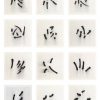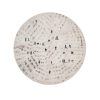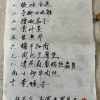Mingjun Luo mainly explores the concepts of identity and memory. Divided between Chinese and Swiss cultures, she conceives of her work as a “third space”, a hybrid and fertile ground where she develops her own language, in a continuous movement between Asia and the West.
Her series ‘Break the Character’ contradicts the Chinese tradition by presenting fragmented and decomposed ideograms to the point of abstraction. The deconstruction of Chinese characters and their loss of semantic value causes them to become abstract, while retaining the essence of traditional ink calligraphy. In this way, all observers are on an equal footing in front of the artwork, and the two traditions and cultural identities can find a meeting point and dialogue.
Probing simultaneously her roots and current identity, Mingjun Luo interrogates her relationship with the world, marked by exile. In the circular work ‘Traces of Writing’, which contains the ideograms of the ‘Daodejing’, a fundamental text of Taoism attributed to the Chinese philosopher Laozi, who lived between the 4th and 5th centuries B.C., the artist writes ideograms that seem to disappear in a fog, melting into oblivion. The text, she says, is her response to the traces of history that come and go, false and real, unpredictable.
WORKS ON DISPLAY
拆字系列
Rompi il carattere cinese
Break the Chinese Character
1993-1998. Ink on rice paper. 35x35cm
书写的痕迹
Tracce di Scrittura
Traces of Writing
2024. Ink on cotton cloth on wooden frame. 150cm ⊘
Menù per la cena di famiglia
Family Dinner Menu
2024. Ink on rice paper. 30×21,5 cm
BIOGRAPHY
Mingjun Luo (Nanchong, China, 1963) studied oil painting at the Hunan Academy of Fine Arts between 1979 and 1983. Passionate about Western history, literature and philosophy, she moved to Switzerland in 1987 where, driven by a deep sense of nostalgia for her native country, she rediscovered ink painting and Chinese calligraphy, which she practiced daily. Fusing Chinese traditions with contemporary Western art forms, she began to deconstruct the strokes of ideograms and rewrite words, achieving abstraction while preserving the authentic essence of writing. In this way, all observers are on an equal footing in front of the artwork, and the two traditions and cultural identities can find a point of encounter and dialogue.


